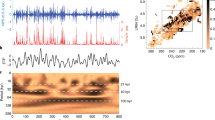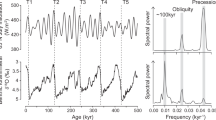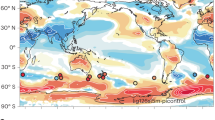Abstract
A series of transient global warming events1,2 occurred during the late Palaeocene and early Eocene, about 59 to 50 million years ago. The events, although variable in magnitude, were apparently paced by orbital cycles2,3,4 and linked to massive perturbations of the global carbon cycle5,6. However, a causal link between orbital changes in insolation and the carbon cycle has yet to be established for this time period. Here we present a series of coupled climate model simulations that demonstrate that orbitally induced changes in ocean circulation and intermediate water temperature can trigger the destabilization of methane hydrates. We then use a simple threshold model to show that progressive global warming over millions of years, in combination with the increasing tendency of the ocean to remain in a more stagnant state, can explain the decreasing magnitude and increasing frequency of hyperthermal events throughout the early Eocene. Our work shows that nonlinear interactions between climate and the carbon cycle can modulate the effect of orbital variations, in this case producing transient global warming events with varying timing and magnitude.
This is a preview of subscription content, access via your institution
Access options
Subscribe to this journal
Receive 12 print issues and online access
$259.00 per year
only $21.58 per issue
Buy this article
- Purchase on Springer Link
- Instant access to full article PDF
Prices may be subject to local taxes which are calculated during checkout




Similar content being viewed by others
References
Zachos, J. C., Dickens, G. R. & Zeebe, R. E. An early Cenozoic perspective on greenhouse warming and carbon-cycle dynamics. Nature 451, 279–283 (2008).
Lourens, L. J. et al. Astronomical pacing of late Palaeocene to early Eocene global warming events. Nature 435, 1083–1087 (2005).
Westerhold, T. et al. On the duration of magnetochrons C24r and C25n and the timing of early Eocene global warming events: Implications from the Ocean Drilling Program Leg 208 Walvis Ridge depth transect. Paleoceanography 22, PA2201 (2007).
Galeotti, S. et al. Orbital chronology of Early Eocene hyperthermals from the Contessa Road section, central Italy. Earth Planet. Sci. Lett. 290, 192–200 (2010).
Dickens, G. R., O’Neill, J. R., Rea, D. K. & Owen, R. M. Dissociation of oceanic methane hydrate as a cause of the carbon isotope excursion at the end of the Paleocene. Paleoceanography 10, 965–971 (2005).
Zachos, J. C. et al. Rapid acidification of the ocean during the Paleocene–Eocene thermal maximum. Science 308, 1611–1615 (2005).
Agnini, C. et al. An early Eocene carbon cycle perturbation at ∼52.5 Ma in the southern Alps: Chronology and biotic response. Paleoceanography 24, PA2209 (2009).
Zachos, J. C., McCarren, H., Murphy, B., Rohl, U. & Westerhold, T. Tempo and scale of late Paleocene and early Eocene carbon isotope cycles: Implications for the origin of hyperthermals. Earth Planet. Sci. Lett. 299, 242–249 (2010).
Kurtz, A., Kump, L., Arthur, M., Zachos, J. & Paytan, A. Early Cenozoic decoupling of the global carbon and sulfur cycles. Paleoceanography 18, 1090 (2003).
Svensen, H. et al. Release of methane from a volcanic basin as a mechanism for initial Eocene global warming. Nature 429, 542–545 (2004).
Zachos, J. C., Lohmann, K. C. & Walker, J. C. G. Abrupt climate change and transient climates during the Paleogene—a marine perspective. J. Geol. 101, 191–213 (1993).
Dickens, G. R., Castillo, M. M. & Walker, J. C. G. A blast of gas in the latest Paleocene: Simulating first-order effects of massive dissociation of oceanic methane hydrate. Geology 25, 259–262 (1997).
Sluijs, A., Brinkhuis, H. & Schouten, S. Environmental precursors to rapid light carbon injection at the Palaeocene/Eocene boundary. Nature 450, 1218–1221 (2007).
Abdul-Aziz, H. et al. Astronomical climate control on paleosol stacking patterns in the upper Paleocene-lower Eocene Willwood formation, Bighorn Basin, Wyoming. Geology 36, 531–534 (2008).
Sluijs, A. et al. Paleocene-early Eocene paleoenvironments with special emphasis on the Paleocene–Eocene thermal maximum (Lomonosov Ridge, Integrated Ocean Drilling Program Expedition 302). Paleoceanography 23, PA1S11 (2008).
Rohl, U., Norris, R. D. & Ogg, J. G. Causes and Consequences of Globally Warm Climates in the Early Paleogene Vol. 369 (Geological Society of America Special Paper, 2003).
Lunt, D. J. et al. CO2-driven ocean circulation changes as an amplifier of Paleocene–Eocene thermal maximum hydrate destabilization. Geology 38, 875–878 (2010).
Winguth, A., Shellito, C., Shields, C. & Winguth, C. Climate response at the Paleocene–Eocene thermal maximum to greenhouse gas forcing—a model study with CCSM3. J. Clim. 23, 2562–2584 (2010).
Zeebe, R. E. & Zachos, J. C. Reversed deep-sea carbonate ion basin gradient during Paleocene–Eocene thermal maximum. Paleoceanography 22, PA3201 (2007).
Panchuk, K., Ridgwell, A. & Kump, L. R. Sedimentary response to Paleocene–Eocene thermal maximum carbon release: A model-data comparison. Geology 36, 315–318 (2008).
Dickens, G. R. Rethinking the global carbon cycle with a large, dynamic and microbially mediated gas hydrate capacitor. Earth Planet. Sci. Lett. 213, 169–183 (2003).
Paillard, D. The timing of Pleistocene glaciations from a simple multiple-state climate model. Nature 391, 378–381 (1998).
Cramer, B. S., Wright, J. D., Kent, D. V. & Aubry, M-P. Orbital climate forcing of δ13C excursions in the late Paleocene–early Eocene (chrons C24n–C25n). Paleoceanography 18, 1097 (2003).
Nicolo, M. J., Dickens, G. R., Hollis, C. J. & Zachos, J. C. Multiple early Eocene hyperthermals: Their sedimentary expression on the New Zealand continental margin and in the deep sea. Geology 35, 699–702 (2007).
Charles, A. J. et al. Constraints on the numerical age of the Paleocene–Eocene boundary. Geochem. Geophys. Geosyst. 12, Q0AA17 (2011).
Sexton, P. F. et al. Eocene global warming events driven by ventilation of oceanic dissolved organic carbon. Nature 471, 349–352 (2011).
Raymo, M. E. The timing of major climate terminations. Paleoceanography 12, 577–585 (1997).
Cox, P. M., Betts, R. A., Jones, C. D., Spall, S. A. & Totterdell, I. J. in Meteorology at the Millennium (ed. Pearce, R.) 259–279 (Academic, 2001).
Dunkley-Jones, T. et al. A Paleogene persepctive on climate sensitivity and methane hydrate instability. Phil. Trans. R. Soc. A 368, 2395–2415 (2010).
Sluijs, A. et al. Subtropical Arctic Ocean temperatures during the Palaeocene/Eocene thermal maximum. Nature 441, 610–613 (2006).
Acknowledgements
D.J.L. and A.R. acknowledge support from the UK Natural Environment Research Council grant NE/F001622/1. A.R. acknowledges support from The Royal Society in the form of a University Research Fellowship as well as NE/F002408/1 and NE/I006443/1. A.S. acknowledges support from the Netherlands Organisation for Scientific Research (NWO-Veni grant 863.07.001) and the research leading to these results has received funding from the European Research Council under the European Community’s Seventh Framework Programme (FP7/2007-2013) / ERC Grant agreement 259627, awarded to A.S. This work was supported by NSF Grant OCE-0903014 to J.Z. S.H. acknowledges support from the UK Natural Environment Research Council grant NE/F021941/1.
Author information
Authors and Affiliations
Contributions
D.J.L. and A.R. conceived the GCM model experiments and the threshold model; S.H. carried out the calculation of HSZ and the transient hydrate modelling. All authors interpreted and discussed the results and wrote the paper.
Corresponding author
Ethics declarations
Competing interests
The authors declare no competing financial interests.
Supplementary information
Supplementary Information
Supplementary Information (PDF 3378 kb)
Supplementary Information
Information about the zip file (PDF 101 kb)
Supplementary Information
Supplementary Information (ZIP 127 kb)
Rights and permissions
About this article
Cite this article
Lunt, D., Ridgwell, A., Sluijs, A. et al. A model for orbital pacing of methane hydrate destabilization during the Palaeogene. Nature Geosci 4, 775–778 (2011). https://doi.org/10.1038/ngeo1266
Received:
Accepted:
Published:
Issue Date:
DOI: https://doi.org/10.1038/ngeo1266
This article is cited by
-
Rapid light carbon releases and increased aridity linked to Karoo–Ferrar magmatism during the early Toarcian oceanic anoxic event
Scientific Reports (2022)
-
Astrochronology of the Paleocene-Eocene Thermal Maximum on the Atlantic Coastal Plain
Nature Communications (2022)
-
Paleocene/Eocene carbon feedbacks triggered by volcanic activity
Nature Communications (2021)
-
Large Igneous Province thermogenic greenhouse gas flux could have initiated Paleocene-Eocene Thermal Maximum climate change
Nature Communications (2019)
-
Earth system feedback statistically extracted from the Indian Ocean deep-sea sediments recording Eocene hyperthermals
Scientific Reports (2017)



